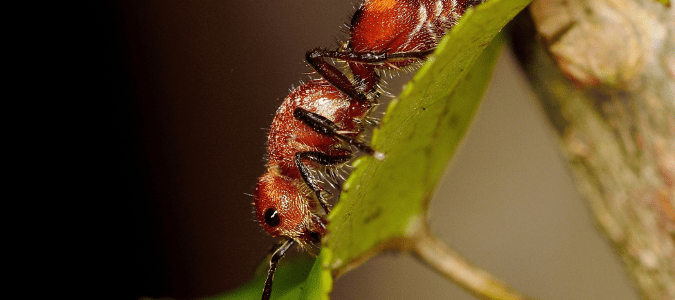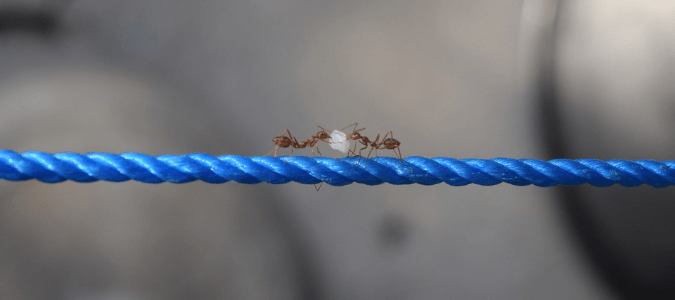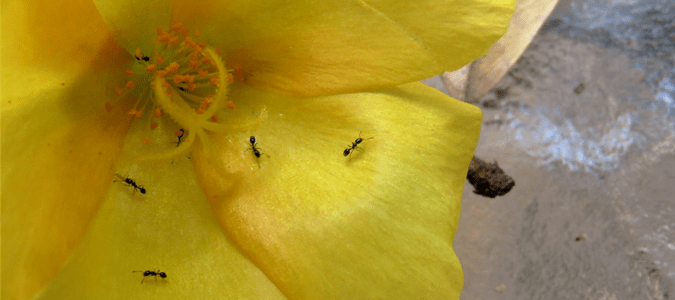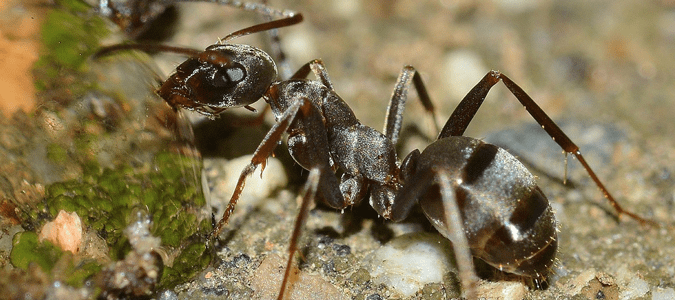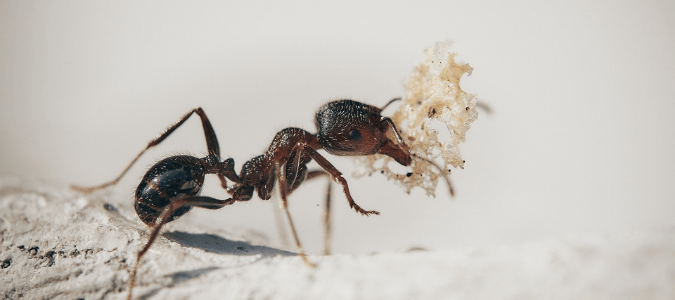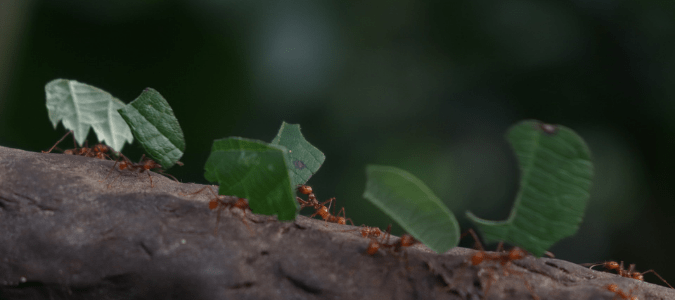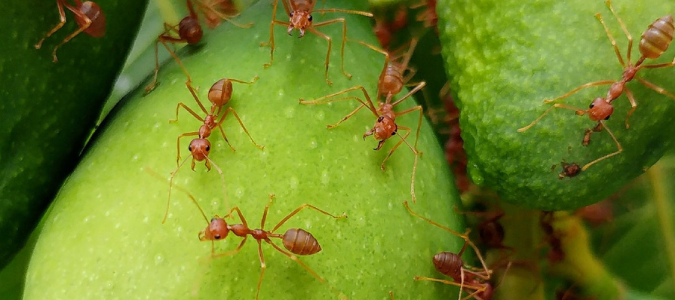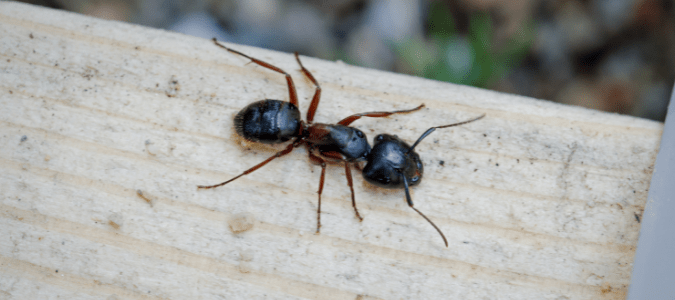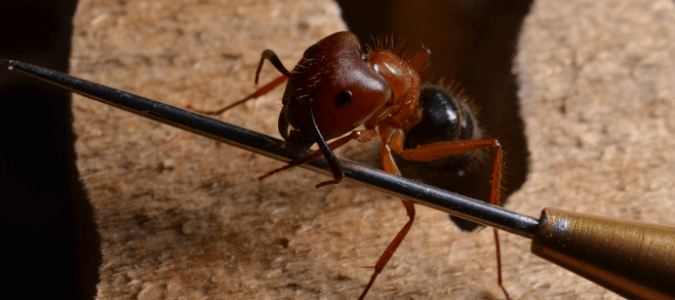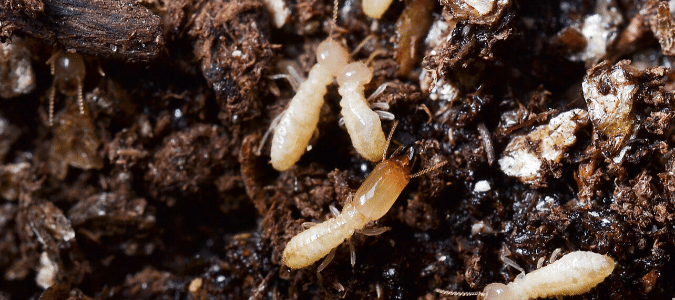When a line of ants shows up in your home, marching across a countertop or going about their business under the sink, thoughts immediately turn to whether the ants are there to wreak havoc, sting pets or family members or worse. Texas is home to several types of ants, all with varying degrees of threat to your home and those who live in it. Let’s take a look at the potential suspects and how you can tell them apart and assess whether you need to contact a professional for ant control.
“Crazy” Ants
These ants get their name because of their seemingly haphazard movement. They look like they are running around in no particular pattern. When they are disturbed or feel threatened, they get even more frantic.
Pictured above, this species looks a lot like carpenter ants but they are smaller and don’t generally have the dark abdomen that carpenter ants have.
Pharaoh Ants
These ants, also known as sugar ants, are fairly small, usually around 1/12 to 1/16 of an inch long, with a body color ranging from light tan to a reddish shade. These are the ants most usually found indoors in the state.
Pharaoh ants don’t sting and usually won’t bite. They feed on sweets like cakes and breads, hence the name sugar ants, and greasy or fatty foods. You will find them just about anywhere inside: Light sockets, plants, walls, cracks and crevices, especially anywhere near water or warmth. They do not swarm like some other ant species in Texas.
Little Black Ants
These ants are related to the Pharaoh ant and they build their nests in soil under rocks, logs or debris, or bare soil patches in lawns. They also like to live in piles of firewood, bricks or stones and they will move into wood that has been damaged by termites.
These are usually the ants that you see marching along sidewalks, coming up from small craters of fine soil to look for food. You will also see them lined up along sidewalks and home foundations and traveling up the sides of buildings.
While little black ants do have stingers, they are so small that their bite isn’t generally a problem. Their biggest threat is just being a nuisance when they get inside your home and into your food!
Odorous House Ants
As you can probably tell from the name, these little guys have a distinct odor about them. They are black ants, but a little larger than the little black ants listed above. Odorous house ants can be about half the length of your pinky finger nail, growing about double that size in some cases. Their coloring ranges from dark brown to black.
They move very quickly and have small heads, but the easiest way to identify them is by the unpleasant odor they give off when they feel threatened or are crushed. It has been described as smelling like rotten coconut. Odorhouse house ants also have a stinger and will bite, as they can be very aggressive.
Acrobat Ants
Acrobat ants are another species you will find in Texas that have an odor problem. Much like the odorous house ants, these ants will emit a foul odor when they feel threatened. Their coloring ranges from a light yellow-brown to black and some are even multicolored.
These ants are named acrobat ants because they are able to hold their heart-shaped abdomens up and over the rest of their body, which they do when they or their nest are disturbed. If you get close enough to see that action, you will also have to deal with their smell!
Texas Leaf Cutting Ants
You are unlikely to find these ants in your home but they can cause issues in your lawn. Texas leaf-cutting ants build many hills around their colonies and work to harvest vegetation. Fungus that grows on this vegetation is their food.
The only way to stop any ongoing damage to your lawn from this species of ants is to get rid of the entire colony. Talk to a licensed professional to find out how they can remove these ants and keep your lawn looking great.
Fire Ants
If you live in Texas and have felt the hot sting of an ant bite, chances are you ran across a fire ant. Their bite creates a painful blister and is not something you will soon forget!
You can identify fire ants by their red and black coloring, large eyes and two nodes on their bodies. Removing the threat from fire ants requires a mound-by-mound elimination and an annual treatment to keep them from building new homes around yours. A licensed pest professional will be able to formulate the exact fire ant treatment that will work best for your home and yard.
Carpenter Ants
There are at least 18 species of carpenter ants in Texas. The one you will find most often in the state is about ¼ to ⅜ of an inch long with a reddish-brown head and thorax and a black tail. The winged variety of this type might be all black. Other species of carpenter ants in Texas can be yellow to black, and they have a pinched waisted, elbowed antennae (this is a definite distinguisher from termites), a bump between the abdomen and a thorax that is evenly rounded.
Carpenter ants generally nest in trees, but they can enter and live inside homes as well. You will most likely see them in late winter or early spring, which is when the ants come out of nests to mate and try to create new colonies. If you see carpenter ants that are large and have wings, that is a general indicator that the ants’ nest is inside the structure of your home. These flying carpenter ants can invade your home over several days.
It is often difficult to control carpenter ants as they don’t respond favorably to most baits. Calling in a licensed professional is your best bet to ensure the pests are controlled.
Are Carpenter Ants Bad?
Of all the ant species, carpenter ants are the most problematic. While they don’t spread disease or illness, carpenter ants can bite and they can cause damage to the wood that makes up your home. If they are nesting inside a home, they will usually be found in narrow and protected areas such as doors, window frames and walls. The species of carpenter ants found in the South prefer to next in open cavities or voids and are not likely to excavate wood further. They might damage a door or window frame or isolated piece of wood, but they won’t cause structural issues.
One thing it’s important to note, however, is that they are still classified as wood-destroying insects and need to be reported on a sale so leaving an infestation untreated or damage unrepaired can affect the resale value of your home. Fortunately, carpenter ants do not cause damage like termites do.
Are Termites Ants?
These sometimes get the name “white ants” because they do share basic similarities with ant species. They don’t have wings, plus they live in groups and come out and work together to find food. Termites, which are pictured above also have a caste system with queens and workers, just like ants.
However, termites are not ants. Ants lay eggs that transform into maggots, then pupa and finally adult ants. Termite eggs transform into tiny termites. Whereas ants are similar to wasps and bees, termites are more closely related to cockroaches than ants, despite the similarities.
Termites eat cellulose whereas ants eat a variety of items that we also eat, such as honey, seeds and meat. What is made of cellulose in a home? Wood framing, carpet, insulation, and Sheetrock, just to name a few of their favorites. A termite infestation can be serious business,
Termite workers can live a year or two, and a queen might live up to a decade! They could potentially sneak their way into the very bones of your home, digging in and causing a great deal of damage before they are discovered.
A licensed pest expert will be able to survey your home and look for any signs that you might have a termite problem. Once termites are discovered, your pest professional will be able to recommend the best, most effective treatment to eliminate them so you can repair any damage and get your home back to the way it was pre-termites.
ABC Can Control the Ants on Your Property
As you can see, there are many types of ants that you might see around your home and lawn. Not all of them are harmful, but even with the descriptions here, it can be difficult to discern which ones you need to look out for. If you’re in need of carpenter ant control, fire ant control or another type of ant control, ABC Home & Commercial Services can help. Our professionals will identify which ant you’re dealing with and will create an effective treatment plan.
